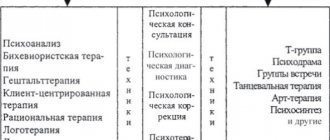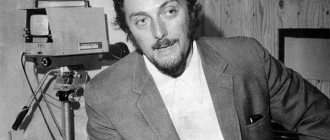Psychology is an interesting science that is more than a hundred years old.
And for more than a hundred years, psychologists have been studying our consciousness, our psyche, our thinking and behavioral characteristics. But you shouldn’t think that psychology is one big house that lives according to the same laws. There are many scientific schools in this science that look at the mechanisms of our psyche from their own special angle. One of these schools is associative psychology.
This school understands the mental process, its functioning and dynamics through associations. Association is a psychological term that characterizes a certain process on which thinking is largely based; it is associated with the fact that the appearance of one thought or one image can cause the appearance of another thought or another image.
Experiment
The ideas of Hartley and Hume, as well as other representatives of associative psychology, migrated to other directions and became the basis for new research. One of these was the associative experiment in psychology, its development was carried out by E. Kremelin, K. Jung, W. Wundt and other researchers.
This method is used both to study the interaction of people in a group and to study the internal processes of an individual. Thanks to the dynamics that are set in the experiment, the subject makes involuntary associations. And they are the basis for studying the thought process of both a given person and a group of people.
We recommend: Define your archetype
The association experiment is widely used in various fields of psychology to obtain reliable information:
It is used as a method of speech analysis, namely to study the vocabulary of the subject. To do this, subjects are presented with a list of words (about a hundred) and are asked to write their own association for each word (the first word that comes to mind) - no more than 10 minutes are allotted for this experiment. It is also used as part of psychophysiological studies to assess the correct understanding of stimuli
For example, a subject is presented with a certain stimulus (usually a word) and attention is paid to his physiological reaction - for example, how quickly the subject begins to salivate after the researcher says the word “lemon”. As a method of analyzing interaction within a group, to understand who is the leader and who is the outsider, as well as how cohesive the group is. It is interesting that the experiment in question is also actively used in criminology: with the help of associations, a suspect’s involvement in a particular crime is determined. In such cases, “reliable” are those associations that the suspect makes immediately, without thinking, since thinking can lead to false data.
As you can see, this experiment is used quite widely and in completely different areas of modern psychology. We should not forget that in many ways associations demonstrate not only the conscious part of our psyche, but also the subconscious. It is not for nothing that this method was used by psychoanalysts, whose subject of study was our unconscious.
Namespace
There are well-established connections that are inherent in society and the linguistic environment. These images include the name space. Most of the modern names have ancient origins and are therefore associated with their original meaning.
In national cultures, names are often associated with a certain character trait (or appearance).
An example in Russian culture is the name Catherine; the word, due to the historical characteristics of the country’s development, receives a connection with “great” and with the original meaning “immaculate.”
The perception of the estate is influenced by its famous bearers. A famous example of an association in space named after Louis “the Sun” XIV is the French king. The rulers of the dynasty received this name over several centuries. Because of this, when many people mention the name, they associate it with royal attributes, Paris, France.
Many cultures have their own list of “unlucky names.” For example, these are the names of Christian martyrs - Tatyana, Fedor (although this tradition was not very widespread in Rus'). Such lists create negative associations that can spread and strengthen, deliberately predetermining the negative connotation of emerging connections.
A name space is a conditional set of generally accepted associations that can be positive or negative. This area is influenced by known bearers of a particular name.
Methods of carrying out
It is also important to understand that an associative experiment can take place in different ways. There are three main ways to conduct this experiment:. 1
No limits. Here the subject can freely express his associations both orally and in writing. The only limitation may be the number of associations
1. No restrictions. Here the subject can freely express his associations both orally and in writing. The only limitation may be the number of associations.
2. Having a direction. In this case, the researcher limits and thereby directs the flow of associations of the subject (for example, it is necessary to name associations only in the form of adjectives).
3. Along the chain. The main limitation here is time. For one stimulus, a person must make several associations in a chain at once; usually the subject is given only a couple of minutes for this.
Recommended: What is an alternative?
After the experiment, data is collected, analyzed, and conclusions are drawn - for example, regarding the associative norm. Frequent reactions to stimuli in the sample will be considered the norm, something familiar to the majority, but isolated cases will be considered a rarity. The most common reactions are formed into an associative field, which is then used in subsequent experiments.
This method is one of the simplest and most accessible in psychology - moreover, the data obtained from this experiment are quite reliable. After all, in order to “launch” the flow of associations in a subject, nothing is needed except the stimulus words themselves.
Reflexology, reactology, psychotechnics
Reflexology is a natural science direction in psychology that developed in 1900-1930, mainly in Russia, and is associated with the activities of V.M. Bekhterev, “considering mental activity as a set of reflexes formed as a result of the influence of the external environment on the nervous system of animals and humans. Reflexology was limited to the study of objectively observable reactions of the animal and human body to external and internal stimuli, ignoring the “subjective” aspects of individual and collective consciousness”[6, p.136]. Bekhterev “puts forward reflexology as a special discipline, different from physiology and psychology and should replace the latter. The struggle against psychology as such begins. It is not certain idealistic trends in psychology, but psychology itself, since it makes the psyche the subject of study, that is declared idealism” [5, p.84].
Reactology is a branch of psychology that interprets it as the “science of behavior” of living beings; it was founded by K. N. Kornilov. The central concept of reactology is “reaction”. Her task “was to study the speed, strength and form of the reaction using various methods. Reworking the concept of “reflex” and expanding it to the category of “reaction” made it possible, according to representatives of this direction, to carry out a “synthesis” of subjective and objective psychology.”[2, p.88].
Psychotechnics is a branch of psychology that became widespread in the 1910-1930s. and studied the application of psychology to practical issues, mainly related to occupational psychology, career guidance and selection. Currently, the content of psychotechnics, its problems and methods have entered the sphere of applied psychology: labor psychology, organizational psychology, engineering psychology.
Basic concept
If we bring together the ideas of all researchers in this direction, we can highlight the key principles of associative psychology:
- The soul was called and understood by researchers as consciousness. This was the first attempt to break away from the influence of theology on science and look at mental processes from a different angle.
- Our mental life is based on simple elements - these are sensations. They are basic and paramount.
- The researchers included feelings, thinking and ideas as secondary elements.
- According to the principle of associations, primary sensations are formed into secondary elements, i.e. the complex consists of a collection of simple elements.
- The more often an association is repeated, the more firmly it becomes entrenched in the psyche. It must be said that the frequency of repetition of associations is associated with emotional experiences, since they are the main stimulus for repetition, because the stronger the emotion, the stronger the connection will be.
Generally speaking, the associative theory of thinking reduced the entire thought process to the emergence of associative connections. Unfortunately, this theory could not explain such a process as creativity, calling it an innate, original function of thinking, although later researchers proved that this function is not innate.
The main and most noticeable limitation of this direction was the use of the method of introspection, or self-observation. Most of the conclusions were made by scientists based on an analysis of their consciousness and the processes that take place in it, while their assessment was given exclusively subjectively, which means it could not be extended to other people.
It must be said that in the 20th century this theory became obsolete and was replaced by new directions. But the concept of associations, which was introduced by these scientists, entered psychological science and is actively used to this day. For example, an association experiment was created based on this concept.
Personal connection tools
Associations are based on conditioned reflex reactions. Each external stimulus causes the appearance of a focus of excitation in the cerebral hemispheres of the cerebral cortex.
These factors are:
More than 9,000 people have gotten rid of their psychological problems using this technique.
- smells;
- words;
- sounds;
- tactile sensations;
- thoughts.
In the lesion, an electrical impulse passes through the neurons, which spreads across areas of the cerebral cortex. During this period, traces of previous passages of the impulse are activated and images that arose earlier upon contact with the object are recalled from memory.
The process of creating associations is necessary for the normal functioning of consciousness and increasing the efficiency of thinking, and is regulated by several tools:
- Memory and the information stored in it. Strengthening memory and expanding horizons create the opportunity for more quality associations to emerge. The result is the development of diverse and new connections.
- Imagination , which processes information, changes and combines combinations of elements in new forms of images. The work of imagination enriches a person’s memory; the resulting associations are used in thinking.
- The speed of passage of a nerve impulse or the occurrence of nervous processes, which regulates the speed of reflex reactions. Greater speed forces the brain to quickly create associations, the variety of which depends on the person’s level of knowledge.
- Unconscious . The process of creating connections is based on the sudden spread of excitation deep into the cerebral cortex and connects the subconscious to thinking. Due to the fact that a large amount of information is stored in this area of perception, associations are an opportunity to interact with the unconscious.
The set of associations is individual for each person, as it is created under the influence of the individual’s experience and knowledge.
Associationism explanation
ASSOCIANISM (associationism) - One of the main directions of world psychological thought, which explains the dynamics of mental processes by the principle of association. It originates from Aristotle. Materialistic associationism has become leading in the so-called associationist psychology. She dominated until the beginning of the 20th century
and focused on the study of mental activity and cognition. The principle was developed especially clearly in the works of D.
Locke, who coined the term association. According to Locke, ideas of sensation precede ideas of reflection in the course of development; simple ideas, when associated, form complex ones; knowledge is based on experience, the sources of experience are sensation and reflection; from these sources the mind receives ideas, but innate ideas do not exist: a person is born as a blank wax tablet on which you can write anything you want. This idea began to be directly related to pedagogical practice, and later - to the problems of personality psychology and pedagogical psychology. It formed the basis of the so-called environmental theories, which assert the leading role of the environment and external influences in the formation of the psyche. They are opposed by development theories emanating from the ideas of J.-J. Rousseau and asserting the priority of the internal laws of development of man. At the beginning of the 19th century. concepts appeared that separated association from its bodily substrate and presented it as an immanent principle of consciousness. The view that formed the basic principles of associationism was established:
1) the soul is understood as consciousness - primarily in its cognitive aspect;
2) simple elements lie at the basis of mental life; the psyche, identified with introspectively understood consciousness, is built from elements - sensations, the simplest feelings;
3) these elements - images of sensations - have a sensual character; they are primary, and complex mental formations - ideas, thoughts, feelings - are secondary;
4) more complex formations arise as the addition of simpler ones based on the principle of association;
5) the condition for the formation of associations is the contiguity of two mental processes;
6) the consolidation of associations is determined by the vividness of the associated elements and the frequency of repetition of associations in experience;
7) the source of knowledge about the soul is introspection; observing his own inner world, the researcher is directly turned to real mental life and has the right to make judgments about it, while someone else’s mental life is inaccessible for analysis, although the laws of mental life are assumed to be uniform.
Another important detail: in essence, a person was understood as a loner living among other similar loners; his inner world is explicitly or implicitly opposed to everything else; there seems to be a rigid boundary between him and the rest of the world. Thanks to advances in biology and neurophysiology, associationism was transformed. Helmholtz used a new view of association in his studies of the sense organs, C. Darwin - in explaining emotions, I. M. Sechenov - in the doctrine of brain reflexes
Spencer's evolutionary approach introduced the problem of the development of the psyche in phylogenesis into associationism and came to an important conclusion about the adaptive function of the psyche in behavior. In the 80s - 90s
XIX century Numerous studies have been undertaken on the conditions for the formation and updating of associations. At the same time, the limitations of their mechanistic interpretation were shown. Associationism in its development went through a number of stages:
1) highlighting association as an explanatory principle for individual mental phenomena, primarily the processes of remembering;
2) the stage of classical associationism, when holistic concepts of the psyche were created, which was understood as a system of mechanical connections (associations) between mental elements, which were considered sensations and ideas;
3) the stage of experimental and practical associationism, characterized by an attempt to introduce the factor of the subject’s activity into the basic concept. Within the framework of associationism, valuable ideas were developed, primarily in the field of the psychology of memory and the psychology of thinking. The very concept of association is very valuable. However, association as a universal explanatory principle turned out to be insufficient over time, and the time of crisis and fall came for associationism as a universal psychological theory. The deterministic elements of associationism in a transformed form were accepted by I. P. Pavlov’s teaching on conditioned reflexes, as well as, on other methodological grounds, by American behaviorism. The study of associations to identify the characteristics of various mental processes is also used by modern psychology (=> associative experiment).
History of origin
The prerequisites for the emergence and development of associative psychology were the research and scientific works of philosophers and psychologists of antiquity. Plato and Aristotle were among the first to talk about associations, but by this term they understood processes associated with memories.
Subsequently, Descartes and Spinoza, using the principles of association, tried to understand how the thinking process occurs and how a person copes with his emotions. But the term itself, as we know it, was introduced by John Locke back in 1698. Although Locke was not the founder of this trend, he contributed to its formation.
Associative psychology began to actively develop in the late 18th and early 19th centuries. It must be said that its development became the main impetus for the development of psychology as an independent science. After all, it was with the light hand of representatives of this school that experimentation and such a branch as experimental psychology began to develop.
The main “inspirer” of this trend was the physicist Newton. It must be said that it was his progressive view of the nature of things, especially the law of attraction, that became the basis for understanding mental processes.
It is impossible to single out one founder of the direction - associative theory; this direction of psychology developed gradually, and its most prominent representatives are J. Berkeley, D. Hume, D. Hartley, T. Brown, G. Spencer. Each of them brought something of their own and filled associative psychology with new meanings.
1. J. Berkeley's theory was based on the ideas of sensationalism. The main meaning of this concept is that the world around us is just a collection of different sensations (sight, taste, smell, touch). Thanks to their interconnection, we get a “three-dimensional” picture of the world. All sensory experience is formed according to the principle of associations (for example, when a person perceives a cup, vision “reads” the image, and touch - tactile sensations, and through association these sensations are combined into one).
We recommend: Art therapy
2. For D. Hume, the principle of associations became the basis of his concept; he drew a parallel between the attraction of some images to others with the help of associations - with the law of attraction of physical bodies. He also highlighted two principles:
- The similarity of ideas attracts them to each other in time and space.
- The more similarities between ideas, the faster the association will arise.
Thus, for example, being frightened or surprised by something unusual in a confined space can cause claustrophobia.
3. D. Hartley was the first to think about the connection between mental processes and physiology. He put forward the idea that vibrations from the surrounding world enter our inner world through the senses, then create vibrations in the nerve endings, which bring information (vibration) to the brain.
Actually, this idea was the basis for explaining the functioning of many cognitive processes, such as sensations, perception, and thinking. It can be said that Hartley was one of those who first tried to describe the work of the nervous system and the flow of nerve impulses.
We recommend: What is adaptation?
4. T. Brown began to study more seriously the mechanics of the thinking process. From his point of view, this process is associated with finding the correct association from a large number of inappropriate associations (when we try to solve a problem and go through options). He was also the first to detail sensations and, for example, identified the distinction between heat and cold as part of the sense of touch. In addition, he turned to the concept of “need” and came to the conclusion that it is based on two sensations: one associated with a feeling of discomfort and the need for an object, and the second with the removal of this discomfort.
5. G. Spencer began to look at mental processes more progressively; he took the theory of evolution as a basis. He began to talk about the need to explore the inner world, the psyche in the context of its interaction with the outside world - thus, he expanded the general approach to mental processes and began to go beyond a simple study of associations. Interaction with the outside world, in his opinion, is based on adaptation: it is by building associations with objects of the outside world that a person is able to adapt and adjust to changes. Moreover, this scientist was the one who identified the main milestones in the development of the human psyche.
It is important to understand that when associative psychology began to develop, theological ideas still dominated the world. Therefore, many thinkers, especially at the beginning of the period, started from the concepts of “spirit”, “soul”, “divine”. But with the rise of science, especially biology and physics, psychology began to incorporate their ideas into its research and look at the human psyche through the prism of new data.
We recommend: Ambivalence is
Associative psychology
So, associative psychology is a special direction, built on the following principles:
- ideas of reflection come after ideas of sensations. This statement means that mental activity is concentrated on any specific content of our consciousness;
- thanks to association, it is possible to combine simple ideas and considerations into complex ones;
- reflection and sensations are the most important sources of experience. In turn, experience can only be obtained with some knowledge;
- there are no innate ideas. They all come from the sources of the mind. The birth of a person triggers a mechanism that records all the knowledge and experience gained in the process of life;
Having paid attention to associative psychology, many began to use it together with pedagogical practice, which began to immediately bear fruit. Later, associative psychology established itself as an integral part of the effective solution of problems in personality psychology
It was thanks to such psychology that it was possible to create a theory of the environment, which points to the decisive role in the formation of the psyche from external influences and the environment.
3.Psychoanalysis
Psychoanalysis is a psychological theory developed in the late 19th and early 20th centuries by the Austrian neurologist Sigmund Freud, and an extremely influential method of treating mental disorders based on this theory.
Having first emerged as a method of treating neuroses, psychoanalysis gradually became a general theory of psychology. Discoveries based on the treatment of individual patients have led to greater understanding of the psychological components of religion, art, mythology, social organization, child development and pedagogy. Moreover, by revealing the influence of unconscious desires on physiology, psychoanalysis has made a significant contribution to understanding the nature of psychosomatic illnesses. Psychoanalysis views human nature from the point of view of conflict: the functioning of the human psyche reflects the struggle of opposing forces and tendencies. At the same time, the influence of unconscious conflicts, the interaction in the psyche of forces that the individual himself is not aware of, is especially emphasized. Psychoanalysis shows how unconscious conflict affects the emotional life and self-esteem of an individual, his relationships with other people and social institutions. The source of conflict lies in the very conditions of human experience. Man is both a biological and a social being. In accordance with his biological inclinations, he strives to seek pleasure and avoid pain. This obvious observation is known as the “pleasure principle,” which describes a fundamental tendency in human psychology. Numerous psychoanalytic observations have shown that childhood experiences of satisfaction and frustration play an important role in the formation of personality.
Associative psychology and associative experiment
Psychology is an interesting science that is more than a hundred years old. And for more than a hundred years, psychologists have been studying our consciousness, our psyche, our thinking and behavioral characteristics.
But you shouldn’t think that psychology is one big house that lives according to the same laws. There are many scientific schools in this science that look at the mechanisms of our psyche from their own special angle. One of these schools is associative psychology.
This school understands the mental process, its functioning and dynamics through associations. Association is a psychological term that characterizes a certain process on which thinking is largely based; it is associated with the fact that the appearance of one thought or one image can cause the appearance of another thought or another image.
Gestalt psychology.
Gestalt psychology owes its appearance to the German psychologists Max Wertheimer, Kurt Koffke and Wolfgang Köhler, who put forward a program for studying the psyche from the point of view of holistic structures - gestalts. Opposing the principle put forward by psychology of dividing consciousness into elements and constructing complex mental phenomena from them, they proposed the idea of the integrity of the image and the irreducibility of its properties to the sum of the properties of the elements. According to these theorists, the objects that make up our environment are perceived by the senses not as individual objects, but as organized forms. Perception is not reduced to the sum of sensations, and the properties of a figure are not described through the properties of its parts. Gestalt itself is a functional structure that organizes the diversity of individual phenomena.
Studying human thinking, Gestalt psychologists proved that mental operations when solving creative problems are subject to special principles of Gestalt organization (“grouping”, “centering”, etc.), and not to the rules of formal logic.
So, “consciousness was presented in Gestalt theory as an integrity created by the dynamics of cognitive structures that are transformed according to psychological laws” [4, p. 113].
Your health is our goal
"VitaPortal" occupies one of the first places among the official medical sites in RuNet in terms of the number of users. For many of them, we have become their favorite medical site, and we strive to justify their trust by constantly updating and updating information about human health. Our mission is to create more healthy people. And providing verified information is our way to achieve our goal. After all, the more informed our user is, the more careful he will be with his main asset - health.
The VitaPortal team includes certified doctors and experts in their fields, candidates and doctors of medical sciences, health journalists
Installation theory (D.N. Uznadze)
An attitude is an unconscious psychological state, an internal quality of a subject based on his previous experience, a predisposition to a certain activity in a certain situation. The attitude precedes and determines the development of any form of mental activity. It acts as a state of mobilization, readiness for subsequent action. It is determined by the corresponding situation and the subject’s need to satisfy it. The presence of a person’s attitude allows him to react in one or another specific way to a particular political or social event or phenomenon.
The phenomenon was discovered by the German psychologist Ludwig Lange; the general psychological theory of attitude, based on numerous experimental studies, was developed by D. N. Uznadze and his school (1956).
The stages of attitude formation are most fully revealed on the basis of the concept of contrast illusion. Along with the unconscious simplest attitudes, more complex social attitudes, value orientations of the individual, etc. are distinguished.
Uznadze's set theory originated and developed as a theory describing one of the forms of unconscious nervous activity. He tried to explain the phenomena of perception, as a reflection of reality, and the behavior of a living being. It gradually became obvious that the facts and patterns considered by the theory of attitudes were general psychological in nature. Therefore, attitude theory began to claim the role of a general psychological concept.
Types of associations
The first known classification of associations was created by Aristotle, and we still use it. The ancient philosopher identified three types of connections:
- By similarity. In order for this connection to arise between two objects or phenomena in the human brain, they must be similar in some way: appearance, color, emotional impact, etc. Thus, the number 2 is associated with a goose, the sky with the ocean , and a snowy plain with a white sheet.
- By contiguity. This common type of connection occurs when we frequently perceive some objects at the same time. For example, the smell of pies can cause an association with home, with childhood, with an affectionate grandmother; the sound of the surf means happy holidays, and the aroma of tangerines and pine needles means happy New Year. This type also includes verbal associations born from set expressions. For example, in response to the word “willow”, many people will think of “weeping”, birch - white-trunked, oak - mighty, etc. But an association by contiguity can also reflect the presence of a real connection or interaction between objects. Thus, a hat is associated with the head, a cart with a horse, and the moon with the night.
- By contrast. This is the most complex type of association, difficult to explain. The image that appears in the mind causes an association with its opposite in meaning. So, if you say the word “day,” most people will remember night. Summer - winter, heat - cold. Such associations are the source of interesting vivid metaphors, for example comparing snowflakes to sparks.
Later, Aristotle's classification was supplemented by one more type. Associations by meaning are the result of the analysis of information and the emergence of complex logical and semantic connections in the human brain. They are largely individual and determined by personal experience, but there are also ones that are understandable to most people. For example, rain means a runny nose, the sea means an airplane. It is not difficult to establish a semantic connection between them.
Bibliographic list of references
- Godefroy J. What is psychology. In 2 volumes. Moscow 1994.
- Karpenko L.A., A.V. Petrovsky, M.G. Yaroshevsky. Brief psychological dictionary. Rostov-on-Don. Phoenix 1998.
- Maklakov A.G. General psychology. Peter 2007.
- Petroshevsky A.V., M.G. Yaroshevsky. Psychology. Moscow 2001.
- Rubinshtein S.P. Fundamentals of general psychology. Peter 1999.
- Umrikhin V.V. “The beginning of the end” of behavioral psychology in the USSR. Repressed science. Peter. 1991.
Examples of similar educational works
Guiding personal development in the process of activity
... transfer of experience of activity Purposeful management of the process of personal development 4. social-role interaction of the individual 5. process ... behavior in society; 5. impact on the consciousness of the individual 421. Techniques: gratitude, approval, reward, ...
Development of a young person’s personality through intellectual and creative games
... personality development of adolescents. One of the most important tasks of all additional education institutions is working with deviant teenagers. Taking into account the specifics of psychology... enhancing the cognitive activity of adolescents... to be carried out by people distant...
Peculiarities of mental development of an adult’s personality
...and the personality of an adult. A new stage in the scientific activity of B.G. Ananyev was the period of development of the idea of a comprehensive study of man and the construction on its basis of an age-related periodization of development. In the articles “Man as...
Problems of personality development in educational activities
... and psychology on the problem of personality and its development, there were three main directions: biological, sociological and biosocial. Representatives of the biological school, considering personality to be a purely natural being, all human behavior...
Seminar 1: personality development, leading activity, education, training
... Is the principle “personality is formed in activity” violated in this case? ... talk about: the arbitrariness of human behavior, the development of “genuine” independence and ... Psychologist D. Myers [Myers D. Psychology / Transl. from English I.A. Starovoitova;. ...











